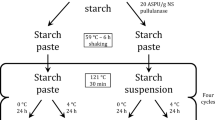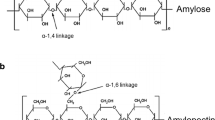Abstract
In the present study, tropical starches from three botanical sources, namely millet starch obtained from the grains of Pennistum glaucum (L) R Br (family Poaceae), sorghum starch from the grains of Sorghum bicolor L. Moench (family Gramineae) and cocoyam starch from the tubers of Colocasia esculenta (L) Schott (family Araceae), have been modified and evaluated as directly compressible excipients in tramadol tablet formulations. The starches were extracted from the relevant plant parts, modified by pregelatinization followed freeze-drying and used as directly compressible excipients in tramadol tablets, and the tablet properties compared with those made with the natural forms of the starches. The results indicate that starches from the three botanical sources vary in their properties and pregelatinization led to the modification of the physicochemical and material properties of the starches. The pregelatinized starches exhibited better flowability and compressibility than the natural starches. Tramadol tablets prepared with freeze-dried pregelatinized starches generally exhibited higher crushing strength but lower friability than those prepared with the natural starches. The rankings of the crushing strength and the disintegration and dissolution times was cocoyam > millet > sorghum starches, with tramadol tablets containing freeze-dried pregelatinized starches exhibiting significantly (p < 0.01) higher disintegration and dissolution times than tablets made with the natural forms of starches. The freeze-dried pregelatinized starches were suitable as directly compressible excipients and provided controlled release of tramadol indicating their potential application in formulations where slower drug release is desired.




Similar content being viewed by others
References
Adebayo AS, Itiola OA (2003) Effects of breadfruit and cocoyam starch mucilage binders/on disintegration and dissolution behaviors of paracetamol tablet formulations. Pharm Technol 3:78–90
Akin-Ajani OD, Itiola OA, Odeku OA (2014) Effect of acid modification on the material and compaction properties of fonio and sweet potato starches. Starch/Stärke 66:749–759
Alebiowu G, Itiola OA (2002) Compressional characteristics of native and pregelatinized sorghum, plantain and corn starches and the mechanical properties of their tablets. Drug Dev Ind Pharm 28:663–672
Alebiowu G, Itiola OA (2003) The effects of starches on mechanical properties of paracetamol tablet formulations. II. Sorghum and plantain starches a disintegrant. Acta Pharm 53:231–237
Atichokudomchai N, Varavinit S (2003) Characterization and utilization of acid-modified cross-linked tapioca starch in pharmaceutical tablets. Carbohydr Polym 53:263–270
Brunnschweiler J, Luethi D, Handschin S, Farah Z, Escher F, Conde-Petit B (2005) Isolation, physicochemical characterization and application of yam (Dioscorea spp.) starch as thickening and gelling agent. Starch/Stärke 57:107–117
Carr RL (1965) Evaluating flow properties of solids. Chem Eng 72:163–168
Chanapamokkhot H, Thongngam M (2007) The chemical and physicochemical properties of sorghum starch and flour. Kasetsart J Nat Sci 41:343–349
Dare K, Akin-Ajani DO, Odeku OA, Odusote OM, Itiola OA (2006) Effects of pigeon pea and plantain starches on the compressional, mechanical and disintegration properties of paracetamol tablets. Drug Dev Ind Pharm 32(3):357–365
Emiola LC, Delarossa LC (1981) Physicochemical characteristics of yam starches. Food Biochem 5:115–130
European Pharmacopoeia (2008) Council of Europe. Strasbourg, France
Freitas RA, Paula RC, Feitosa JPA, Rocha S, Sierakowski MR (2004) Amylose contents, rheological properties and gelatinization kinetics of yam (Dioscorea alata) and cassava (Manihot utilissima) starches. Carbohydr Polym 55:3–8
Fujita S, Sugimoto Y, Yamashit Y, Fuwa H (1996) Physicochemical studies of starch from foxtail millet (Setaria italica Beauv.). Food Chem 55(3):209–213
Goel H, Kaur G, Rana V, Tiwari AK (2010) Formulation development of stronger and quick disintegrating tablets; a crucial effect of chitin. Yakugaku Zasshi 130:729–735
Hoover R (2001) Composition, molecular structure, and physicochemical properties of tuber and root starch: a critical review. Carbohydr Polym 45:253–267
Hulse JH, Laing EM, Pearson OE (1980) Sorghum and the millets: their composition and nutritional value. Academic Press, New York, pp 33–997
Jayakody L, Hoover R, Liu Q, Donner E (2007) Studies on tuber starches. II. Molecular structure, composition and physicochemical properties of yam (Dioscorea sp.) starches grown in Sri Lanka. Carbohydr Polym 69 (1):148–163
Kizilbash A, Ngô-Minh C (2014) Review of extended-release formulations of Tramadol for the management of chronic non-cancer pain: focus on marketed formulations. J Pain Res 7:149–161
Krishna Kumari S, Thayumanavan B (1998) Characterization of starches of proso, foxtail, barnyard, kodo, and little millets. Plant Foods Hum Nutr 53(1):47–56
Manek RV, Builders PF, Kolling WM, Emeje M, Kunle OO (2012) Physicochemical and binder properties of starch obtained from Cyperus esculentus. AAPS PharmSciTech 13(2):379–388
Moorthy SN, Thankamma Pillai PK, Unnikrishnan M (1993) Variability in starch extracted from taro. Carbohydr Polym 20:169–173
Nasipuri RN (1979) Evaluation of cocoyam starch as tablet binder and disintegrant. Pharm Acta Helv 54(2):48–53
Odeku OA (2013) Potentials of tropical starches as pharmaceutical excipients: a review. Starch/Stärke 65 (1–2):89–106
Odeku OA, Alabi CO (2007) Evaluation of native and modified forms of Pennisetum glaucum (millet) starch as disintegrant in chloroquine tablet formulations. J Drug Del Sci Technol 17(2):155–157
Odeku OA, Picker-Freyer KM (2007) Analysis of the material and tablet formation properties of four Dioscorea starches. Starch/Stärke 59(9):430–444
Odeku OA, Picker-Freyer KM (2010) Freeze-dried pregelatinized Dioscorea starches as tablet matrix for sustained release. J Excip Food Chem 1(2):21–32
Odeku OA, Awe OO, Popoola B, Odeniyi MA, Itiola OA (2005) Compression and mechanical properties of tablet formulations containing corn, sweet potato, and cocoyam starches as binders. Pharm Tech 29(4):82–90
Odeku OA, Schmid W, Picker-Freyer KM (2008) Material and tablet properties of pregelatinized (thermally modified) Dioscorea starches. Eur J Pharm Biopharm 70(1):357–371
Pérez E, Schultz FS, Pacheco de Delahaye E (2005) Characterization of some properties of starches isolated from Xanthosoma sagittifolium (tannia) and Colocasia esculenta (taro). Carbohydr Polym 60(2):139–145
Radley JA (1976) Starch production technology. Applied Science Publishers Ltd, London, pp 189–229
Scott LJ, Perry CM (2002) Tramadol: a review of its use in perioperative pain. Drug 60(1):139–176
Singh N, Singh J, Kaur L, Sodhi NS, Gill BS (2003) Morphological, thermal and rheological properties of starches from different botanical sources. Food Chem 81:219–231
Acknowledgements
This article does not contain any studies performed with human and animal subjects. In addition, all authors (Cecilia O. Alabi, Inderbir Singh and Oluwatoyin A. Odeku) declare that they have no conflict of interest. None of the authors received research grant from any agency for this study.
Author information
Authors and Affiliations
Corresponding author
Rights and permissions
About this article
Cite this article
Alabi, C.O., Singh, I. & Odeku, O.A. Evaluation of natural and pregelatinized forms of three tropical starches as excipients in tramadol tablet formulation. J. Pharm. Investig. 48, 333–340 (2018). https://doi.org/10.1007/s40005-017-0325-9
Received:
Accepted:
Published:
Issue Date:
DOI: https://doi.org/10.1007/s40005-017-0325-9




